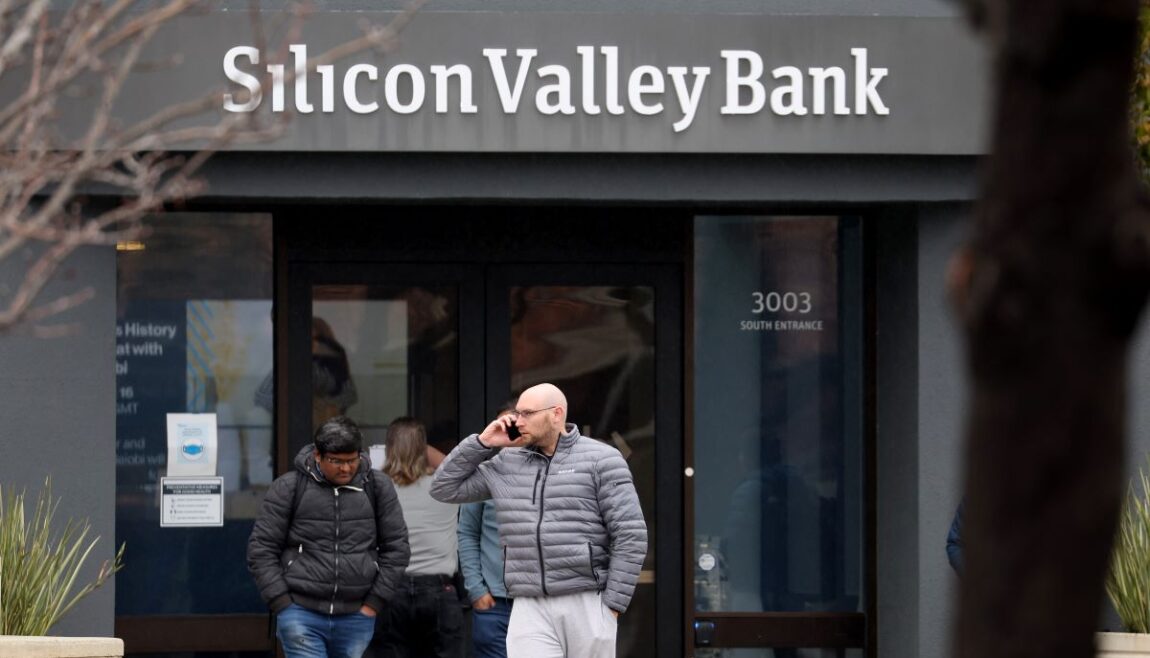How 2018 Regulatory Rollbacks Set the Stage for the Silicon Valley Bank Collapse, and How to Change Course
March 15, 2023
By Todd Phillips

Photo by Justin Sullivan/Getty Images
This weekend saw two of the largest bank failures in US history, including the second biggest ever. Silicon Valley Bank (SVB), the 16th largest bank in the US, with more than $200 billion in assets, was put into receivership Thursday night; and Signature Bank, with just under $100 billion in assets, followed suit. On Sunday evening, the Federal Deposit Insurance Corporation (FDIC) used its “systemic risk exception” to prevent uninsured depositors at these institutions from taking losses, and the Federal Reserve launched a new liquidity facility aimed at taking unrealized losses—losses that result from holding depreciating assets without selling them—off of banks’ balance sheets.
SVB clients were largely startups and other businesses, resulting in a large number of accounts well in excess of the $250,000 ceiling for FDIC insurance. In addition, SVB’s fast growth and asset and liability mix should have been a warning sign to regulators of its potential to fail. These kinds of risks can be mitigated with appropriate regulations and oversight of the kind that Congress enacted in 2010 with the Dodd-Frank Wall Street Reform and Consumer Protection Act. But due to the rollback of several key Dodd-Frank provisions and an emphasis by lawmakers in 2018 that midsize banks receive lighter oversight than large banks, regulators did not supervise these banks sufficiently. This allowed them to get into a financial position where they could not withstand runs. Additional congressional action is needed to close these regulatory gaps, but regulators today also have existing authority to strengthen rules immediately. These regulations should:
- Subject all banks above $100 billion in assets to annual supervisory stress tests, resulting in faster application of the stress capital buffer;
- Restore the modified liquidity coverage ratio for banks between $100 billion and $250 billion;
- Prevent banks with more than $100 billion from opting out of including accumulated other comprehensive income (AOCI) on their balance sheets;
- Return to the pre-2018 capital rules; and
- Require all institutions with more than $100 billion in assets to submit resolution plans annually.
2018’s Regulatory Rollback Made the SVB Catastrophe More Likely
Although the 2008 financial crisis was very different from what we saw this weekend, the Dodd-Frank Act increased regulations and oversight of banks with more than $50 billion in consolidated assets. Among its provisions, it required that institutions of Silicon Valley Bank’s size be subject to regulator- and bank-run stress tests, requirements that holding companies and insured depository institution subsidiaries submit resolution plans (often called “living wills”), and enhanced capital and liquidity rules. Dodd-Frank’s enactment also symbolized the beginning of a new supervisory oversight regime; banks above the $50 billion threshold would be sharply monitored.
But as the scars from 2008 faded, the banking industry began chafing at the tight regulations imposed on midsize and regional banks, which would be considered systemically important anywhere else. Bank lobbying groups called for “regulatory relief” for community banks and “tailored” regulations, such that smaller firms would be less tightly regulated than their larger, national bank peers—ignoring that the rules were already tailored.
As a result of this lobbying, Congress enacted the Economic Growth, Regulatory Relief, and Consumer Protection Act (S.2155) in 2018. S.2155 raised many of the thresholds for enhanced regulations from $50 billion to $250 billion, though it left leeway to the Federal Reserve to reimpose regulations for institutions between $100 billion and $250 billion. The bill also reduced regulations on mortgage origination and appraisals, reduced regulations on banks with less than $10 billion, and weakened the Volcker Rule, among other changes. Further, the fact that the law was bipartisan (the bill had 10 Democratic co-sponsors in the Senate) indicated to regulators that they should minimize their oversight of midsize banks and focus instead on the largest banking institutions.
As Senator Elizabeth Warren warned at the time, “Washington is about to make it easier for the banks to run up risk, make it easier to put our constituents at risk, [and] make it easier to put American families in danger.” Roosevelt’s Mike Konczal similarly explained that S.2155 “removes protections for 25 of the top 38 banks, weakens regulations on the biggest players and encourages them to manipulate regulations for their benefit, and saps consumer protections.”
As expected, regulators did not reinstate restrictions on banks with more than $100 billion in assets. Instead, the Federal Reserve explained that its weakened rules would “reduce compliance requirements for firms with less risk while maintaining the most stringent requirements for the largest and most complex banks.”
SVB was one of the institutions that saw its regulations and oversight weakened.
S.2155 Allowed Regulators to Miss SVB’s Warning Signs
It is easy to pinpoint the exact changes made by S.2155 and the Fed’s regulations that allowed SVB to get to the financial situation in which its collapse was possible, warning signs went unnoticed, and the bank could not be put through receivership without causing greater harm to the financial system.
First, the law exempted banks below $250 billion in assets from company-run stress tests and subjected banks between $100 billion and $250 billion to only periodic supervisory stress tests. The Fed decided to conduct supervisory stress tests on a biannual basis. Because SVB grew so quickly, it was not subject to the last supervisory stress test conducted in 2021. As a result, even though it would have been subject to supervisory stress testing in 2022, it was not tested. Without being stress tested, the bank was also not subject to the stress capital buffer that would have required SVB to fund itself with more regulatory capital.
Second, S.2155 exempted banks below $50 billion in assets from enhanced liquidity requirements and subjected banks between $100 billion and $250 billion to such liquidity rules only if mandated by the Fed. Under the pre-S.2155 regulatory regime, SVB would have had to maintain sufficient high-quality liquid assets on hand to meet redemption requests expected over a 21-calendar day stress scenario (known as the modified liquidity coverage ratio). Following S.2155’s enactment and the Fed’s implementation of weaker regulations, SVB was subject to weaker, bank-run liquidity stress testing and liquidity buffer requirements. Thanks to S.2155 and weaker Fed rules, SVB was also exempted from several other requirements, including risk-based capital requirements and leverage limits, credit exposure reports, and single-party credit limits, though these do not seem to have played a part in its collapse.
Third, the post-S.2155 rule changes raised the threshold at which banks could opt out of including AOCI in their regulatory capital. AOCI are any unrealized gains and losses below retained earnings in the equity section of a bank’s balance sheet. Accordingly, AOCI will affect the level of the bank’s equity. Since 2014, bank capital rules have permitted some institutions to opt out of including AOCI in their regulatory capital. Back in 2014, banks with $250 billion or more in total assets or $10 billion in on-balance sheet foreign exposures could not opt out. However, the Fed’s post-S.2155 rules raised that threshold to $700 billion or more in total assets, or $75 billion in on-balance sheet foreign exposures, allowing many more institutions to opt out.
Thanks to S.2155 and weaker Fed rules, SVB was able to opt out of including AOCI on its balance sheet. As a result, its regulatory capital appeared healthier than it actually was. Indeed, earlier this month, FDIC Chairman Martin Gruenberg noted that total unrealized losses across the banking system were at about $620 billion at the end of 2022, and warned that these “unrealized losses weaken a bank’s future ability to meet unexpected liquidity needs.”
Fourth, S.2155 exempted banks below $50 billion in assets from filing resolution plans and required banks between $100 billion and $250 billion to file such plans only if the Fed mandated. As a result of S.2155 and weaker Fed rules, SVB was never required to submit a resolution plan for the holding company. Further, although before the enactment of S.2155 the FDIC required banks’ depository subsidiaries with more than $50 billion in assets to file resolution plans biannually, the FDIC made changes in 2019 requiring depository subsidiaries with assets between $50 billion and $100 billion to submit plans triannually. As a result, SVB did not submit a resolution plan until December of last year, leaving the FDIC without time to adequately learn how to resolve SVB without causing further damage to the rest of the banking system.
Finally, the passage of S.2155 implicitly gave bank examiners permission to supervise midsize institutions like SVB with a lighter touch. Although the language in S.2155 allowed the Fed to keep enhanced prudential standards on banks between $100 billion and $250 billion, the law passed the Senate 67 to 31. Because it was enacted during the deregulatory Trump administration, a full two-thirds of Senators were tacitly giving regulators the authorization to treat banks below $250 billion in assets like community banks rather than the domestically systemic institutions that they are. Examiners received this message, and acted accordingly.
What Can Regulators and Congress Do Now?
Enacting S.2155 was a mistake. However, even those legislators who voted for it can help reverse course: Because the bill simply implied that regulators should weaken rules on banks of SVB’s size and did not require that result, those representatives and senators should call for regulators to strengthen regulations immediately. The Fed should subject all banks above $100 billion in assets to annual supervisory stress tests, meaning that these institutions will become subject to the stress capital buffer more quickly. The Fed should also restore the modified liquidity coverage ratio for banks between $100 billion and $250 billion, prevent banks with more than $100 billion from opting out of including AOCI on their balance sheets, and restore capital and other requirements that were not implicated in this crisis but may bring about future ones. The FDIC and Fed should require all institutions with more than $100 billion in assets to submit resolution plans annually. Lastly, examiners must supervise institutions more stringently, including by questioning so-called “innovative” business models.
Similarly, the Fed has announced a review of the supervisory failures that led to SVB’s collapse, with results due by early May. This review must be made public, including with excerpts from examination reports.
Congress should also act. At minimum, Congress should amend S.2155 to require enhanced regulation of banks with more than $100 billion in assets to ensure that regulators do not treat these institutions as run-of-the-mill banks. Further, Congress should consider the implications of the FDIC’s use of the systemic risk exception for SVB and Signature Bank; depositors may now assume that all deposits are insured—something that will have significant implications for banking regulations and the health of the FDIC’s Deposit Insurance Fund, regardless of whether it is true. Finally, Congress could also consider launching its own review into the supervisory failures that led to SVB’s collapse in order to learn whether statutory changes are required.
